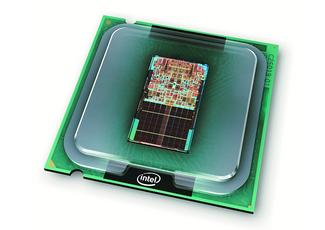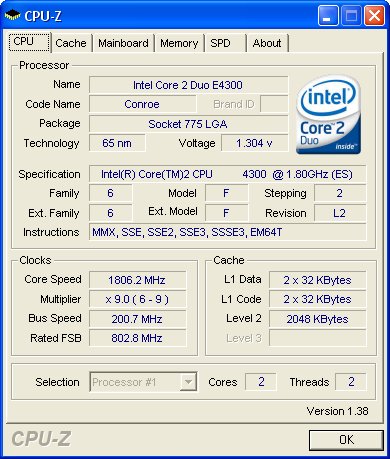CORE 2 DUO E4300 VS PENTIUM D935 REVIEW BENCHMARK AND OVERCLOCK
![]()
|
|
 |
|||||||||||||||||||||||||||||||||
| Posted:2007-01-19 By cpu review Number of View:158984 |
||||||||||||||||||||||||||||||||||
By :cpu review Posted:2007-01-19
The year 2007 starts with INTEL definitely which less than one month after having supplemented by the high end offers processors Core 2 with Core 2 Quad 6600, supplements this time by low-end range Core 2 with the release of Core 2 duo E4300. The advantage of this processor comes of course from its price since for the first time Core 2 duo is proposed under the symbolic bar of 200 euros. The price does not mean all, and Core 2 duo E4300 must prove to be reliable. Knowing the bad habits of INTEL as regards with processor low-end range, we has the right to wonder about the exact nature of the sacrifices authorized to reduce the price of this processor. Sacrifices which we fears because of their possible impact on the performances. In addition, as a happiness never arrives , INTEL launches in parallel, Pentium D 935. Not, Pentium D did not die and the founder of Santa Clara intends well to prove it with this new model resolutely directed to the low-end range!
INTEL Core 2 duo E4300 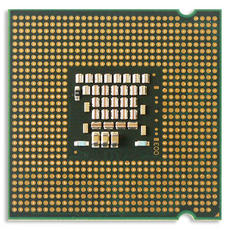 Processor INTEL Core 2 duo E4300
INTEL Core 2 duo E4300: processor
Presenting itself at the format Socket LGA775 and always provided with a metal protecting its core, Core 2 duo E4300 is engraved like its predecessors in 65 Nm. There thus preserves the same thermal envelope fixed at 65 Watts and remains compatible with chipsets for processors Core 2 duo like P965 INTEL or nForce 6xx NVIDIA. With a frequency of operation 1,8 GHz and FSB fixed at 800 MHz, Core 2 duo E4300 uses a multiplying coefficient of 9x. Lastly, its supply voltage can lie between 0,850v and 1,3525v.
Core 2 duo E4300 by CPU-Z
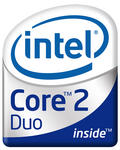 With less than 200 euros the unit, 159 dollars part per quantity of thousand , Core 2 duo E4300 remains a processor dual core , but it does have the same characteristics as its big brothers. It will be noted besides that INTEL clearly indicates the color while choosing a nomenclature in series 4000 and not in series 6000 as for Core 2 current. Concretely, this new model benefits from L2 cache restricted to only 2 MB divided between the two core. INTEL Pentium D 935: last Pentium D?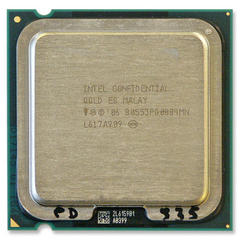 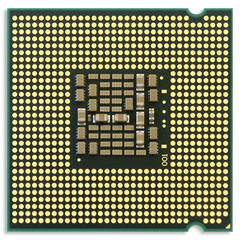 Processor INTEL Pentium D 935 INTEL Pentium D 935: The processor
From Outside it s identical to Core 2 duo, Pentium D 935 uses also Socket 775 and have 376 million transistors. It is also engraved in 65 Nm, but its thermal envelope is higher since is fixed at 95 Watts. Its frequency of operation is 3,2 GHz, that with a multiplying coefficient of 16x for a frequency of buses fixed at 800 MHz. The processor integrates 4 MB in its second level with 2 MB for each core. The voltage of Pentium D 935 is variable and oscillates in general between 1,2v and 1,3375v.
Pentium D 935 seen by CPU-Z 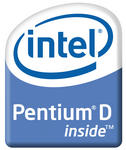 In short, Pentium D 935 will not revolutionize the world of processors, and This is not the objective of INTEL with this new reference. The founder proposes Pentium D 935 primarily as a solution of update to the current owners of platforms Pentium D which do not want to change their motherboard to pass to Core 2 duo. we note in that Pentium D 935 is identical to Pentium D 940 except that it loses the assumption of technology virtualisation ,INTEL VT. OverclockingThe first thing which comes to mind when we considers Core 2 duo E4300 is due of course to its potential of overclocking.. Thus, on our motherboard , we could without changing the multiplying coefficient to pass from FSB800 to FSB1066. Consequently, our given processor with 1,8 GHz operated at 2,4 GHz 33% improvement and this without any effort! 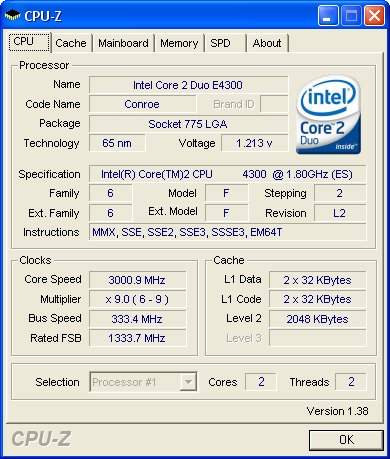 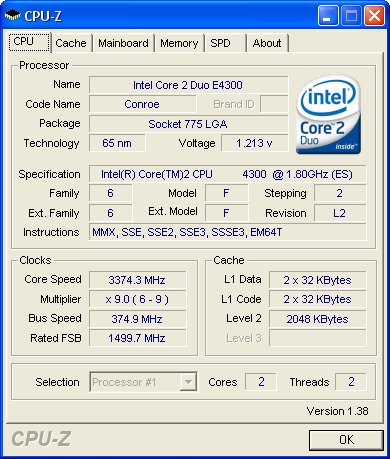 Core 2 duo E4300 flashé to 3 GHz then with 3,4 GHz!
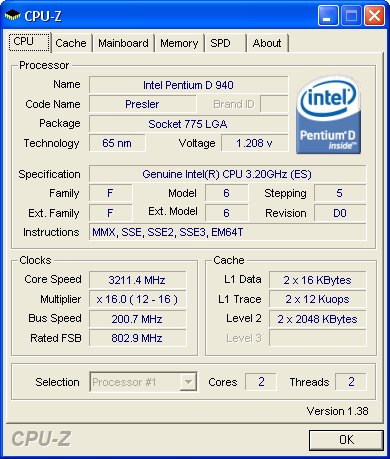 Pentium D 935 working at 4,4 GHz! To check the impact of our various overclockings in performances, we systematically launched our custum demo with FarCry. The results are expressed in the graph below and as u can see it the simple fact of passing from FSB 800 MHz by default to 1066 MHz increases 28% in the performances of Core 2 duo E4300. By reaching the 3,4 GHz our Core 2 duo E4300 does better than Core 2 duo E6700. . As for Pentium D 935, our overclocking boost its performances to 27%: it is well but not sufficient to equalize Core 2 duo! Power ConsumptionWe benefit from this test to check the electric consumption of the last-born children from INTEL. With this intention, we lanched during several minutes the utility Prime 95 then we noted the electric consumption delivered by our wattmeter for the whole configuration. Power Consumption is indicated in the table below and as u can note , Core 2 duo E4300 proves to be particularly modest, and this even in full load! Not more than 174 Watts in full work, when the machine Pentium D 935 reached all the same 214 Watts in full load.
To test the performances of the INTEL Core 2 duo E4300 we had recourse to the configuration whose detail appears bellow:
This platform allowed us to test Core 2 duo E4300 but also to confront it with its similar Core 2 duo E6300 and E6400. We will also integrate Core 2 duo E6600 as reference in our graphs. Naturally, we will not forget the offer from AMD and we will compare here Core 2 duo E4300 with Athlon 64 X2 4200+ EE, its direct competitor in the same price range. To test Athlon 64 X2 4200+ EE and also 4600+ EE, we had recourse to the following configuration:
Our two systems operated under Windows XP Professionnel Service Pack 2 and were provided with the last driver and BIOS available to the date of test. 3DMark 06 - CPU - v1.1.0
PCMark 05 - CPU - v1.2.0
PCMark 05 - Memory - v1.2.0
Sandra Xi -Processor Test
Sandra Xi - Memory Test
ScienceMark 2.0 - Primordia
Cinebench 9.5
Adobe Photoshop CS2
Windows Media Encoder 9.0
Files Compression WinRAR 3.62
3DSMax 8 - Radiosity
TMPGenc 4.2.3.193 Xpress
Pinnacle Studio 10.7Once more results expressed in seconds. At the head we finds Core 2 duo E6700 followed by Core 2 duo E6400. Athlon 64 X2 4600+ EE finishes third with equality with Core 2 duo E6300. The small last of INTEL, Core 2 duo E4300 is 17 seconds here slower than Core 2 duo E6300 but this was enough to win over Athlon 64 X2 4200+ EE. Pentium D 935 is here the slowest processor. Mathematica 5.1
Doom 3 v1.3 - 1024x768x32
Far Cry v1.4 - 1024x768x32
Call Of Duty 2 - v1.3 - 1024x768x32
Conclusion
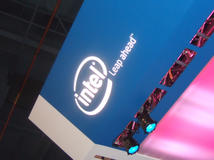 On its side, Pentium D 935 show modest overall . it is not a bad processor. It offers performances equal to Core 2 duo E4300 using default frequency, is negotiated with a completely advantageous price and it can easily be overclocked! we could make easily pass from clock speed of 3,2 GHz to 4,4 GHz! even if Pentium D 935 preserves the defects of family Pentium D, with a high consumption and important heating, it remains particularly interesting to update at few expenses an existing platform Pentium D. On the other hand, we will not advise Pentium D 935 for new equipment because of reduced evolutionarity which offers the attraction of Core 2 duo whose price is hardly 50 euros more expensive.
we would be happy to answer for your question . if you have suggestion or comment
regarding this review our support would be glad to help just join our forum and ask u will get the best answer
to discuss check our forum section :-) RATE THIS REVIEW | ||||||||||||||||||||||||||||||||||
![]()

core 2 duo e4300 vs pentium d935 review benchmark and overclock
core 2 duo e4300 vs pentium d935 review benchmark and overclock


7600gt review
7600gt is the middle card range.
We already benchmarked this video card and found that ...

 geforce 8800gtx and 8800gts
geforce 8800gtx and 8800gts  Xtreview software download Section
Xtreview software download Section  AMD TURION 64 X2 REVIEW
AMD TURION 64 X2 REVIEW  INTEL PENTIUM D 920 , INTEL PENTIUM D 930
INTEL PENTIUM D 920 , INTEL PENTIUM D 930  6800XT REVIEW
6800XT REVIEW  computer hardware REVIEW
computer hardware REVIEW  INTEL CONROE CORE DUO 2 REVIEW VS AMD AM2
INTEL CONROE CORE DUO 2 REVIEW VS AMD AM2  INTEL PENTIUM D 805 INTEL D805
INTEL PENTIUM D 805 INTEL D805  Free desktop wallpaper
Free desktop wallpaper  online fighting game
online fighting game  Xtreview price comparison center
Xtreview price comparison center 

- The new version of GPU-Z finally kills the belief in the miracle of Vega transformation
- The motherboard manufacturer confirms the characteristics of the processors Coffee Lake
- We are looking for copper coolers on NVIDIA Volta computing accelerators
- Unofficially about Intels plans to release 300-series chipset
- The Japanese representation of AMD offered monetary compensation to the first buyers of Ryzen Threadripper
- This year will not be released more than 45 million motherboards
- TSMC denies the presentation of charges from the antimonopoly authorities
- Radeon RX Vega 64 at frequencies 1802-1000 MHz updated the record GPUPI 1B
- AMD itself would like to believe that mobile processors Ryzen have already been released
- AMD Vega 20 will find application in accelerating computations
- Pre-orders for new iPhone start next week
- Radeon RX Vega 57, 58 and 59: the wonders of transformation
- ASML starts commercial delivery of EUV-scanners
- The older Skylake processors with a free multiplier are removed from production
- Meizu will release Android-smartphone based on Helio P40
- AMD Bristol Ridge processors are also available in American retail
- The fate of Toshiba Memory can be solved to the next environment
- duo GeForce GTX 1080 Ti in GPUPI 1B at frequencies of 2480-10320 MHz
- New Kentsfield overclocking record up to 5204 MHz
- Lenovo released Android-smartphone K8



computer news computer parts review Old Forum Downloads New Forum Login Join Articles terms Hardware blog Sitemap Get Freebies

